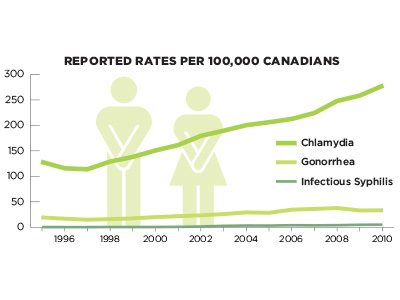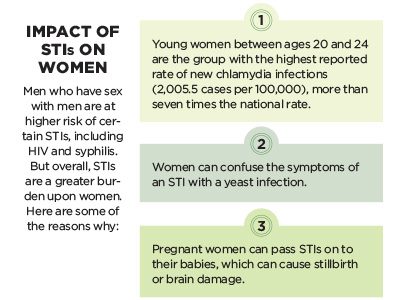Intercourse Issues
Charting the rise of sexually transmitted infections in Canada.

Chlamydia, gonorrhea and syphilis have a lot in common: they’re all caused by bacteria, spread by sex and nasty in their potential complications. The incidence of all three has also been rising steadily in Canada since the late 1990s. The reason for this is unclear, though it may be no coincidence that the tide turned at around the same time highly effective antiretrovirals for managing HIV/AIDS first appeared. With HIV no longer the death sentence it once was, some public-health officials posit, safe sex may seem less crucial in Canadians’ eyes.
Younger people are far more likely than older ones to contract a sexually transmitted infection (STI), possibly because of their degree of activity: according to a Statistics Canada survey, roughly one-third of sexually active 15-to-24-year-olds said they’d had more than one partner in the past year. However, the relative rate of infection is increasing most quickly among middle-aged and senior adults. With unwanted pregnancy no longer a concern, and with very few safe-sex campaigns aimed at older Canadians, it’s not surprising that condom use declines with age. To make matters worse, older folks generally received less sex education in their youth and are more reluctant to discuss sexual health with their doctors.
Chlamydia, the most common STI, accounts for 51 per cent of all the infectious diseases the federal government requires doctors to report for tracking purposes. And the actual number of cases probably outnumbers the reports by far, because the “silent disease,” as it is called, is often asymptomatic. It’s estimated that more than 50 per cent of infected men and 70 per cent of infected women are unaware of their condition.
Both chlamydia and the next-most prolific STI, gonorrhea, can be cured with antibiotics, but if left untreated, they can lead to serious troubles, including, for women, pelvic inflammatory disease-which can lead to chronic pelvic pain, ectopic pregnancy and infertility. For men, complications are less common and less severe but include orchitis, a painful swelling of the testicles.
Most people know that condoms and dental dams are the best shield against STIs, but the non-profit medical research group Mayo Clinic nevertheless recommends regular testing. In 2011, the city of Ottawa decided to simplify access to STI screening by offering printable lab forms for chlamydia and gonorrhea testing at gettestedwhynot.ca. Instead of visiting a family doctor or clinic, Ottawans can go straight to a lab with their forms to give a urine sample. This is the first program of its kind in Canada and, given the growing scope of the problem, hopefully not the last.



